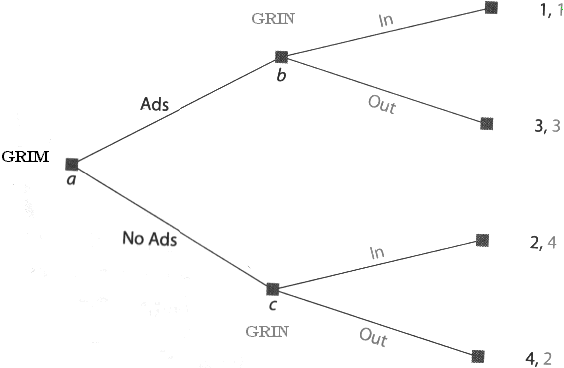|
|
|
|
Game Theory Introduction - Sequential-Move Games |
|
Thus far, we have looked at games which are inherently simultaneous in nature. That is, the players take actions simulataneously and are not able to wait and see what their opponents did. In contrast, we can think of situations which have a strict order of play: players take turns making moves, and they know what players who have gone before them have done. |
|
Example - Political Campaign |
|
Many examples in the business and political world have such sequential aspects. Suppose that a particular Senate seat is currently occupied by Grim ( the incumbent). A potential challenger for Grim?s seat is Congressman Grin! In this race, Grim must decide whether to launch a preemptive advertising campaign and Grin has to decide whether to enter the race. Grim can advertise and convey his fantastic qualities and his oppnent?s despicable ones, or he can abstain from advertising and reach out to fewer constituents at lower cost. Grin has to decide whether to come into the race or stay out. We assume that the order of play entails the incumbent Grim making a choice regarding his advertising campaign first and the challenger, Grim making an entry decision after observing Grim?s advertising strategy. |
|
There are four possible scenarios to consider:
|
|
How would you look at this situation? |
|
Payoffs in the Game |
|
First let us decide how the two players would rate the four possible outcomes. Game thorists would turn the ratings into payoffs, that associate numerical values with each outcome and have those values increase with the attractiveness of the outcomes. Take Grim first. Assume he likes best the outcome ?Grim doesn?t advertise/Grin stays out?; his rating of this outcome is associated with a payoff say of 4. The situation ?Grim advertises/Grin enters? is the worst for Grim, with a payoff of say 1. Of the remaining two outcomes, Grim prefers ?Grim advertises/Grin stays out? to "Grim doesn?t advertise/Grin enters? since running unopposed increases his reputation. So the former outcome yields a payoff of 3 in Grim?s rating and the latter gets a payoff of 2. |
|
For Grin, the best situation ( a payoff of 4) is ?Grim doesn?t advertise/Grin enters?. The outcome ?Grim advertises/Grin stays out? is next with a payoff of 3, because Grin can then say to the party leaders that Grim?s ads made the campaign hopeless. Next comes the outcome ?Grim doesn?t advertise/Grin stays out." In this case the party leaders regard Grin as a wimp and may not support him in the future., and so Grin associates a payoff of 2 with this outcome. Finally, ?Grim advertises/Grin enters? is the worst with a payoff of 1 for Grin because not only does he lose in the election, it damages his reputation for good. It is assumed in this story that given Grim?s incumbency, he is quite likely to retain his seat |
|
The Game Tree |
|
Stories involving sequential moves as this one are usually illustrated in Game Theory using a tree like diagram called a "game-tree" and are referred to as "extensive form". To illustrate the senate race game using a game tree we need to consider the components of the game. The two senators are Grim and Grin. Grim is the first to choose an action in the game, where he decides between no advertising and advertising. Grin makes his decision after Grim when he decides between coming into the race and not coming into the race. The trees for this game then must have three decision making points (nodes), one for Grim to start the game and two for Grin following upon each of the two actions that could be taken by Grim. At the terminal points of the tree we indicate the payoff to each of the two players. See the figure below: |

|
|
|
Page source: http://www.econport.org/econport/request?page=man_gametheory_intro3
|